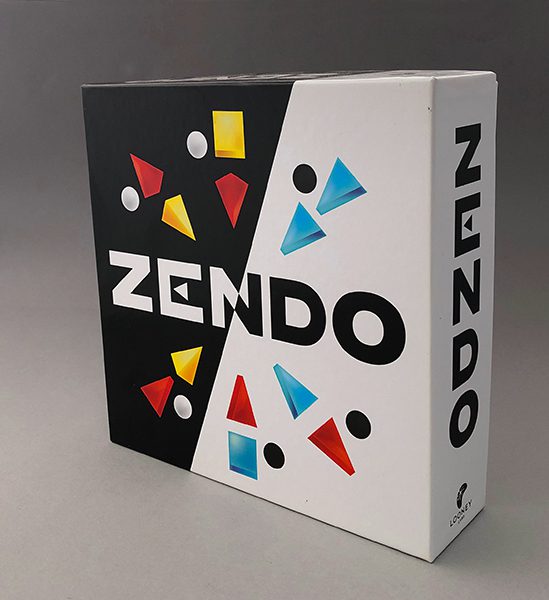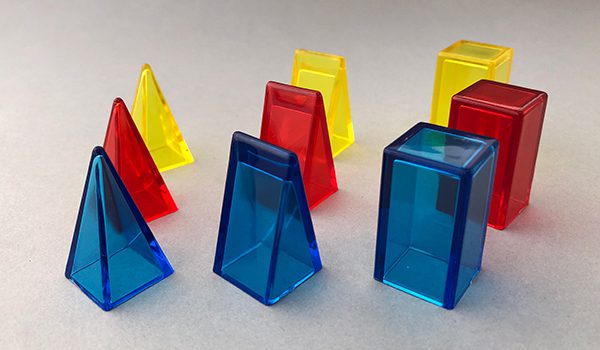Disclosure: Meeple Mountain received a free copy of this product in exchange for an honest, unbiased review. This review is not intended to be an endorsement.
If you take a look at my reviews here on Meeple Mountain you’ll quickly realize something: I like the games from Looney Labs. The staff at Looney Labs put out some clever, imaginative titles. Their games tend to be smaller card games like Fluxx or games that involve the Looney Pyramids.
When Zendo was first published in the early 2000s, it only featured the small, medium, and large pyramids in red, blue, green and yellow. The revised edition has streamlined the colors to yellow, red, and blue, and added shapes. Now, instead of only having pyramids, you also have a wedge and a cube.
If you like games where you need to mull over the current situation and be deliberate in your actions, keep reading.

Set Up
Zendo is a game about guessing the right Rule. There are three types of Rule cards: Easy, Medium and Difficult. For your first games, you’re going to want to put the Medium and Difficult cards back in the box. Trust me, you’ll want to stick with the Easy ones for a bit.
Set out all the pieces within reach of all players. Keep the shapes (pyramid, wedge, and cube) of each of the three colors (red, yellow, and blue) separated for ease of use.

Choose someone to be the Moderator for this round. Each player should take a single black and white disk, then give the Moderator the rest of these disks. Also give the Moderator all the green cubes.
The Moderator selects a random face-down Rule and examines it, making selections as necessary.
Now you’re ready to start playing.
Playing the Game
The Moderator starts by selecting from the various colored shapes to create two structures: one that follows the Rule and one that does not.
Players will each take a turn building another structure. The goal here is to go from the very broad idea of the first two structures and eliminate what isn’t true to discover what the Moderator’s Rule is.

For instance, let’s say the Rule is to have At Least One Flat Blue piece. For one structure, the Moderator might have shapes of all three colors, with the Blue shapes laying flat. The other structure might have only a single red and blue shape, with the red cube on its side. The first of these structures follows the rule; the second does not.
Let’s say the first player builds a structure that consists of yellow and red pieces only, with the red cube laid on its side.
The player then makes a choice as to how they want the Moderator to respond. If the player says, “Tell,” the Moderator will simply place a white (follows the Rule) or black (does not follow the Rule) token in front of the structure.
You can also choose to say, “Quiz.” In this case, all players guess whether the just-build structure follows the Rule or not. If yes, they take the white disk in their fist; if no, they take the black. On a count of three, all players reveal their guesses. Players who guessed correctly get a green cube. Those who did not, get nothing.
After several rounds, you may think you have examined enough different structures and have narrowed down the range of possible ideas and have identified the Rule. At the end of your next turn you may spend one of your green cubes to make an official Guess. This Guess is spoken, using very specific language.
“I think the Rule is that the structure must have at least one vertical blue piece.”
The Moderator then either acknowledges that the Rule has been guessed or, if the guess was incorrect, they must build a new structure that incorporates the guessed criteria yet demonstrates that the Guess was wrong. (In this case, say by building a structure where none of the blue pieces are lying down.)
Play continues in this manner until someone correctly guesses the Rule. That person then becomes the Moderator for the next round.
Thoughts
Designer Kory Heath is quick to point out that Zendo is not a Deductive reasoning game. Rather it is an Inductive reasoning game. Deductive reasoning starts off with an idea that is then examined against a number of different possibilities—all of which must be true—to arrive at a single, logical conclusion. Inductive reasoning takes a specific observation and makes a broad generalization based on the observation. The observation may be true of all instances or just of that specific instance.
Not knowing if your latest structure is true (follows the rule) is at the heart of Zendo. See, you’re not just throwing colored shapes together on your turn; you’re carefully testing one hypothesis after another, narrowing down the possibilities until you Guess correctly.
Zendo could, I suppose, be played competitively, with players scoring a point for every correct Guess. However, in all the games I’ve played, that idea has been quickly tossed aside as players have chosen to work together and discuss conjectures and theories. In this way we play Zendo as a social induction game in the same way we play Rear Window and Whitehall Mystery as social deduction games. The methodologies may be different, but the game play is similar in all the best ways.

Zendo is a very thinky puzzle, one that I acknowledge some people won’t enjoy. There’s no dice-chucking here, no asymmetric player powers, no workers to place or resources to gather. Instead, Zendo presents a clever little enigma built of colors and shapes, and challenges you to work out the hidden meaning. It’s a game that I’ve played with several different groups, all of whom have liked it and asked to play it again.
If you like this sort of game, it is definitely worth getting yourself a copy. The number and variety of Rules (both official from the game itself, through additional booster packs, or fan-made) is large, meaning there’s a lot of replayability in this small box.












Add Comment